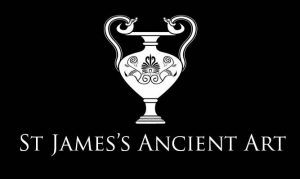As was popular in the Middle Kingdom, this scarab is similarly attributed to a private individual, Har. From the material culture he held the positions of Seal-bearer to the king and companion to the King. Har was most likely of Canaanite origin and lived during the Second Intermediate Period, under the rule of the pharaoh Seshi. This scarab, with its coil border and double register of hieroglyphs, is virtually comparable to a number of scarabs attributed to the pharaoh. Har holds the largest number of scarab seals found and due to the large number we can ascertain that he was of great importance and held both power and influence. In much the same way that royal name scarabs were used by the pharaoh’s subjects, scarabs of Har were distributed widely to his staff beneath him.
Egyptian Steatite Scarab for the Seal-Bearer Har
£ 1,250.00
A steatite Egyptian scarab with incised features and hieroglyphs to the reverse. The obverse features a detailed head and clypeus, with slight indentations at the side for the humeral callosities. The scarab has been decorated extensively to the reverse with inscribed hieroglyphs to form an official formula belonging to the Seal-Bearer of the King, Har. A column of spirals flanks the hieroglyphs in the centre. The scarab is pierced longitudinally for suspension.
The hieroglyphs transliterate as: BATI KHETM, MER KHETM, hAaR.
This translates as ‘Royal sealer, keeper of the seal, Har’.
Period: 14th Dynasty, Second Intermediate Period
Provenance: Ex private collection Mr MT. Previously Den of Antiquity, Cambridge. Previously ex AH private collection.
Condition: Excellent condition. Clear hieroglyphs and well moulded obverse.
| Weight | 6.72 g |
|---|---|
| Dimensions | L 2.5 cm |
| Region | North Africa |
| Stone | Steatite |
Reference: For similar: The Petrie Museum of Egyptian Archaeology, London, UK, item LDUCE-UC11487










